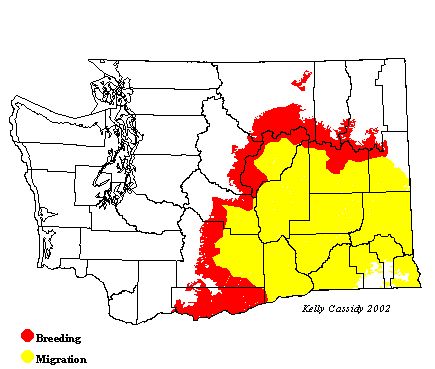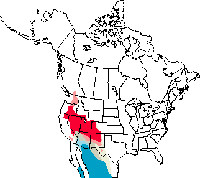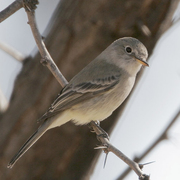Gray Flycatcher
General Description
The Gray Flycatcher is pale grayish overall, and its underparts are paler than those of the other Empidonax flycatchers. It has two white wing-bars and an uneven white eye-ring.
Habitat
Across much of its range, the Gray Flycatcher prefers sagebrush and juniper. In Washington, however, it is primarily a bird of open Ponderosa pine forests with grassy understories. It does extend into sagebrush in some parts of Washington, but mostly sticks to park-like Ponderosa pine stands lacking a shrub-layer. Most of these stands have been logged or thinned, some multiple times.
Behavior
One of the best ways to distinguish between Gray and other Empidonax flycatchers is through behavior. While most Empids flick their tails in a rapid up-down motion, Gray Flycatchers flick their tails much more slowly. The pattern is down, then up; the others flick the tail up, then down. When foraging, they watch from an exposed perch, flying out to catch prey in mid-air, on the ground, or in the foliage. When they overlap with Dusky Flycatchers, they will defend territories from Duskies.
Diet
Gray Flycatchers eat insects.
Nesting
This monogamous species sometimes occurs in loose colonies when habitat is favorable. In Ponderosa pine habitat, nests are typically placed on a large, horizontal branch, against the trunk. The female builds the nest, although the male sometimes helps. The nest is a bulky cup of loose grass, needles, bark, and other material, lined with plant down, feathers, and hair. The female incubates three to four eggs for 14 to 15 days. Both parents feed the young, which leave the nest at about 16 days. The parents continue to feed the young for another 14 days. Over much of their breeding range, they lay a second clutch after the first clutch fledges.
Migration Status
Gray Flycatchers migrate shorter distances than many of their relatives, wintering in southern Arizona, Baja California, and Mexico. They arrive in Washington at the end of April and leave in August.
Conservation Status
Gray Flycatchers were first recorded in Washington in 1970, and first found breeding here in 1972. Since then, they have expanded their range considerably, reaching southern British Columbia in 1986. This rapid expansion may have been due to forest management practices that cleared understory and thinned stands of Ponderosa pine forests, creating the park-like habitat that Gray Flycatchers prefer.
When and Where to Find in Washington
Gray Flycatchers are very rare in western Washington, and are more likely to be seen in Eastern Washington Ponderosa pine forests and shrub-steppe. They are seldom spotted in Washington during migration.
 Abundance
Abundance
| Ecoregion | Jan | Feb | Mar | Apr | May | Jun | Jul | Aug | Sep | Oct | Nov | Dec |
|---|---|---|---|---|---|---|---|---|---|---|---|---|
| Oceanic | ||||||||||||
| Pacific Northwest Coast | ||||||||||||
| Puget Trough | ||||||||||||
| North Cascades | ||||||||||||
| West Cascades | ||||||||||||
| East Cascades | U | U | U | U | R | |||||||
| Okanogan | U | F | F | F | F | |||||||
| Canadian Rockies | ||||||||||||
| Blue Mountains | R | R | R | R | ||||||||
| Columbia Plateau | U | U | U | U | U |
Washington Range Map

North American Range Map


Family Members
 Olive-sided FlycatcherContopus cooperi
Olive-sided FlycatcherContopus cooperi Western Wood-PeweeContopus sordidulus
Western Wood-PeweeContopus sordidulus Alder FlycatcherEmpidonax alnorum
Alder FlycatcherEmpidonax alnorum Willow FlycatcherEmpidonax traillii
Willow FlycatcherEmpidonax traillii Least FlycatcherEmpidonax minimus
Least FlycatcherEmpidonax minimus Hammond's FlycatcherEmpidonax hammondii
Hammond's FlycatcherEmpidonax hammondii Gray FlycatcherEmpidonax wrightii
Gray FlycatcherEmpidonax wrightii Dusky FlycatcherEmpidonax oberholseri
Dusky FlycatcherEmpidonax oberholseri Western FlycatcherEmpidonax difficilis
Western FlycatcherEmpidonax difficilis Black PhoebeSayornis nigricans
Black PhoebeSayornis nigricans Eastern PhoebeSayornis phoebe
Eastern PhoebeSayornis phoebe Say's PhoebeSayornis saya
Say's PhoebeSayornis saya Vermilion FlycatcherPyrocephalus rubinus
Vermilion FlycatcherPyrocephalus rubinus Ash-throated FlycatcherMyiarchus cinerascens
Ash-throated FlycatcherMyiarchus cinerascens Tropical KingbirdTyrannus melancholicus
Tropical KingbirdTyrannus melancholicus Western KingbirdTyrannus verticalis
Western KingbirdTyrannus verticalis Eastern KingbirdTyrannus tyrannus
Eastern KingbirdTyrannus tyrannus Scissor-tailed FlycatcherTyrannus forficatus
Scissor-tailed FlycatcherTyrannus forficatus Fork-tailed FlycatcherTyrannus savana
Fork-tailed FlycatcherTyrannus savana

